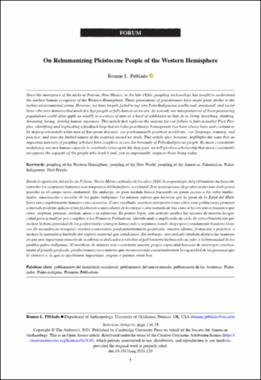| dc.description.abstract | Since the emergence of the niche in Folsom, New Mexico, in the late 1920s, peopling archaeology has sought to understand the earliest human occupants of the Western Hemisphere. Three generations of practitioners have made great strides in the techno-environmental arena. However, we have largely failed to tap into PaleoIndigenous intellectual, emotional, and social lives—the very domains that made Ice Age people as fully human as we are. As a result, our interpretations of those pioneering populations could often apply as readily to a colony of ants or a herd of wildebeest as they do to living, breathing, thinking, dreaming, loving, striving human ancestors. This article first explores the reasons for our failure to fully actualize First Peoples, identifying and implicating a feedback loop that includes practitioner homogeneity (we have always been and continue to be disproportionately white men of European descent); our predominantly positivist worldview; our language, training, and practice; and even the limited nature of the material record we study. This article also, however, highlights the ways that an important minority of peopling scholars have sought to access the humanity of PaleoIndigenous people. By more consistently mobilizing our own human capacity to creatively interrogate the deep past, we will produce scholarship that more consistently recognizes the capacity of the people who lived it and, just as importantly, respects those living today.
Desde la aparición del nicho en Folsom, Nuevo México a finales de los años 1920, la arqueología del poblamiento ha buscado entender los ocupantes humanos más tempranos del hemisferio occidental. Tres generaciones de profesionales han dado pasos grandes en el campo tecno-ambiental. Sin embargo, en gran medida hemos fracasado en ganar acceso a las vidas intelectuales, emocionales y sociales de los paleo-indígenas, las mismas esferas que hicieron que la gente de la Edad del Hielo fuera tan completamente humana como nosotros. Como resultado, nuestras interpretaciones sobre esas poblaciones pioneras a menudo podrían aplicarse tan fácilmente a una colonia de hormigas o una manada de ñus como a los ancestros humanos que viven, respiran, piensan, sueñan, aman y se esfuerzan. En primer lugar, este artículo analiza las razones de nuestra incapacidad para actualizar por completo a los Primeros Pobladores, identificando e implicando un ciclo de retroalimentación que incluye la homogeneidad de los profesionales (siempre hemos sido y seguimos siendo desproporcionadamente hombres blancos de ascendencia europea); nuestra cosmovisión predominantemente positivista; nuestro idioma, formación y práctica; e incluso la naturaleza limitada del registro material que estudiamos. Sin embargo, este artículo también destaca las maneras en que una importante minoría de académicos dedicados a estudiar el poblamiento ha buscado acceder a la humanidad de los pueblos paleo-indígenas. Al movilizar de manera más consistente nuestra propia capacidad humana de interrogar creativamente el pasado profundo, produciremos conocimiento que reconozca más consistentemente la capacidad de las personas que lo vivieron y, lo que es igualmente importante, respete a quienes viven hoy. | en_US |

